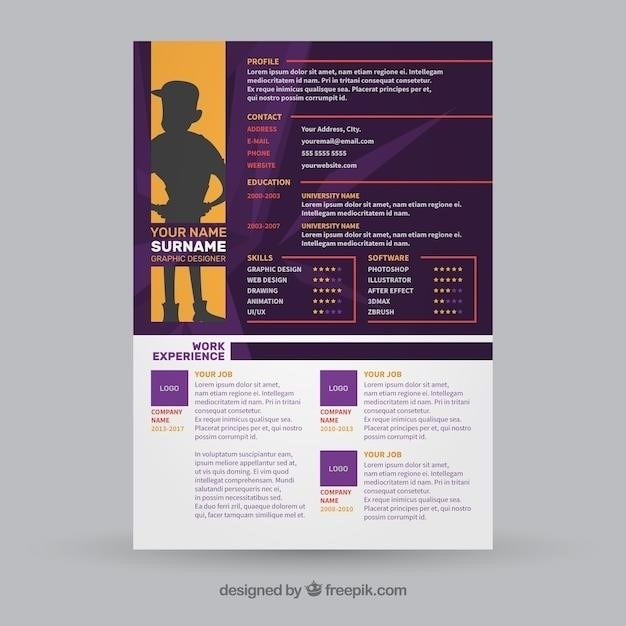DevOps Engineer Resume⁚ PDF Best Practices
Prioritize a PDF format for your DevOps resume; it ensures consistent formatting across different systems and is easily machine-readable by Applicant Tracking Systems (ATS). Keep it concise, ideally one to two pages, highlighting key achievements and quantifiable results using bullet points for clarity.
Resume Length and Format
A DevOps engineer resume should be concise and impactful, ideally fitting within one to two pages. This length allows recruiters to quickly assess your skills and experience without being overwhelmed. Employ a hybrid resume format, combining chronological and functional elements. This showcases both your technical skills and work history effectively. Use clear headings, consistent formatting, and bullet points to improve readability and highlight key accomplishments. Prioritize recent and relevant experiences, ensuring the information is easily scannable.
Highlighting Achievements and Quantifiable Results
Instead of simply listing responsibilities, showcase your accomplishments using quantifiable results. For example, instead of “Managed servers,” write “Reduced server downtime by 15% through proactive monitoring and improved automation, resulting in a $50,000 cost savings.” Use action verbs and quantify your impact whenever possible. Highlight achievements that demonstrate your proficiency in automation, CI/CD pipelines, and cloud technologies. Focus on projects that showcase your problem-solving skills and contributions to team success. This approach demonstrates the value you bring to potential employers.
Essential Sections⁚ Summary, Skills, Experience, Certifications
A strong DevOps resume includes a compelling professional summary highlighting key skills and career goals. A dedicated skills section lists technical proficiencies (e.g., AWS, Docker, Kubernetes, CI/CD tools) and soft skills (communication, teamwork, problem-solving). The experience section details previous roles, focusing on quantifiable achievements and using action verbs. Finally, a certifications section prominently displays relevant credentials like AWS Certified DevOps Engineer or similar, showcasing commitment to continuous learning and industry best practices. Maintain consistent formatting throughout for readability.

Optimizing Your DevOps Resume for Applicant Tracking Systems (ATS)
Use a PDF format, easily parsed by ATS. Incorporate relevant keywords from the job description throughout your resume to improve its searchability by ATS software.
Choosing the Right File Format (PDF)
For DevOps engineer resumes, PDF is the optimal choice. Unlike DOCX files, PDFs maintain consistent formatting across different operating systems and software versions, ensuring your resume appears as intended by the recruiter or Applicant Tracking System (ATS). This is crucial because inconsistencies can lead to your resume being overlooked. PDFs also prevent unintended edits, preserving the professional presentation of your qualifications and experience. While some systems may accept other formats, PDF offers the highest level of reliability and visual consistency, maximizing your chances of a positive first impression.
Using Keywords Effectively
Incorporate relevant keywords throughout your DevOps resume to improve its visibility to Applicant Tracking Systems (ATS) and recruiters. Analyze job descriptions for frequently used terms related to DevOps tools (e.g., Docker, Kubernetes, AWS, Azure), methodologies (Agile, Scrum, CI/CD), and technologies (Python, Bash, Terraform). Naturally integrate these keywords into your skills section, experience descriptions, and project summaries. Avoid keyword stuffing, which can negatively impact readability and appear unnatural. Focus on accurately representing your skills and experience while strategically incorporating relevant industry terminology for optimal ATS and recruiter engagement.
Tailoring Your Resume to Each Job Description
Customize your DevOps resume for each job application. Carefully review each job description to identify key requirements and desired skills. Adjust your resume’s content and emphasis to align with the specific needs of the role. Highlight projects and experiences that directly demonstrate your proficiency in the technologies and methodologies mentioned in the job posting; Quantify your achievements whenever possible, using metrics to showcase your impact. This targeted approach demonstrates your genuine interest and understanding of the position, increasing your chances of getting noticed by recruiters and hiring managers. Don’t simply reuse a generic resume; tailor each one for maximum impact.

Showcasing Key Skills and Experience
Effectively present your technical and soft skills, emphasizing relevant experience and quantifiable achievements. Use action verbs and showcase project examples for impactful demonstration.
Technical Skills⁚ Tools and Technologies
Showcase your proficiency in crucial DevOps tools and technologies. List cloud platforms (AWS, Azure, GCP), containerization (Docker, Kubernetes), configuration management (Ansible, Puppet, Chef), CI/CD pipelines (Jenkins, GitLab CI), and scripting languages (Python, Bash). Mention experience with Infrastructure as Code (IaC) tools like Terraform. Highlight your expertise in monitoring and logging tools (Prometheus, ELK stack), version control systems (Git, SVN), and database management systems (SQL, NoSQL). Demonstrate your knowledge of virtualization technologies (VMware, Hyper-V) and network security.
Soft Skills⁚ Collaboration, Problem-Solving, and Communication
DevOps roles demand strong interpersonal skills. Highlight your collaborative spirit, emphasizing teamwork and effective communication within development and operations teams. Showcase your problem-solving abilities with examples demonstrating your analytical thinking and strategic approach to resolving complex technical challenges. Mention your adaptability in fast-paced environments and your capacity for effective time management and prioritization. Demonstrate your ability to handle pressure, resolve conflicts, and mentor junior team members. Emphasize your proactive approach and commitment to continuous learning.
Project Examples and Quantifiable Results
Showcase your accomplishments using the STAR method (Situation, Task, Action, Result). Quantify your impact whenever possible. For instance, instead of saying “Improved deployment process,” say “Reduced deployment time by 30% through automation, resulting in a 20% increase in release frequency.” Describe projects where you utilized DevOps practices, highlighting your contributions to automation, CI/CD pipelines, infrastructure improvements, and problem resolution. Focus on projects that demonstrate your skills with specific tools and technologies. Each example should clearly show the positive impact you made.
Leveraging Certifications and Education
List relevant certifications like AWS Certified DevOps Engineer or Kubernetes Administrator. Highlight your educational background and any professional development activities demonstrating continuous learning and commitment to the field.
Relevant Certifications for DevOps Professionals
Showcase relevant certifications prominently. Include names like AWS Certified DevOps Engineer, Docker Certified Associate, and Certified Kubernetes Administrator. These demonstrate expertise in cloud platforms, containerization, and orchestration—critical DevOps skills. List the certification name, issuing organization, and date obtained. This highlights your commitment to continuous learning and staying current with industry best practices and standards. Consider adding other relevant certifications based on your experience and the specific job requirements. This section should be easily scannable and visually appealing.
Highlighting Educational Background
Your educational background provides a foundational context for your skills. Include your degrees, relevant coursework (e.g., computer science, software engineering), and the names of institutions attended. List degrees chronologically, starting with the most recent. If relevant, mention any academic projects or research involving DevOps principles, cloud computing, or related technologies. For those with extensive experience, this section might be shorter, focusing on the most relevant educational achievements. If you lack formal education, consider showcasing relevant certifications or online courses to highlight your skills.
Professional Development and Continuous Learning
Demonstrate your commitment to staying current with industry trends by highlighting professional development activities. Include participation in relevant conferences, workshops, or online courses. Mention any self-learning initiatives, such as completing online tutorials or contributing to open-source projects. This section reinforces your dedication to continuous improvement and adaptability, crucial in the rapidly evolving DevOps field. List specific courses, workshops, or certifications obtained, including providers and completion dates, to showcase your proactive approach to skill enhancement.
Crafting a Compelling Professional Summary
Start with a strong opening statement highlighting your key skills and experience. Tailor it to each job description, emphasizing relevant achievements and career goals to capture the recruiter’s attention immediately.
Creating a Strong Opening Statement
Your professional summary is the first impression; make it count! Craft a concise and impactful opening statement that immediately highlights your most relevant skills and accomplishments. Quantify your achievements whenever possible. For example, instead of saying “Improved system reliability,” say “Increased system uptime by 15% through implementation of new monitoring tools.” Use action verbs to showcase your proactive contributions. Focus on the value you bring, aligning your skills with the specific job requirements. A strong opening statement sets the tone for the rest of your resume and encourages recruiters to read further.
Highlighting Career Goals and Aspirations
While brevity is key, subtly weave in your career aspirations within your professional summary. Don’t explicitly state “My goal is to…”, but rather implicitly convey your ambitions through your accomplishments and descriptions. For example, mentioning experience leading teams or spearheading major projects suggests a desire for increased responsibility. Highlighting continuous learning and pursuit of certifications showcases ambition for professional growth. Tailor this aspect to the specific job description, demonstrating your understanding of the company’s needs and how your aspirations align with their growth trajectory. This subtle approach effectively communicates your career trajectory without being overly direct.
Tailoring the Summary to the Specific Job
Generic summaries fail to impress. Analyze each job description meticulously; identify keywords and required skills. Refine your summary to directly address these specific needs. Quantify your achievements whenever possible, showcasing how you’ve met or exceeded expectations in past roles. For instance, instead of stating “Improved efficiency,” write “Improved deployment speed by 20% using Jenkins, resulting in a 15% reduction in downtime.” This targeted approach demonstrates your understanding of the role and company, significantly increasing your chances of getting noticed. Remember to maintain a consistent tone and style throughout your resume.